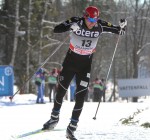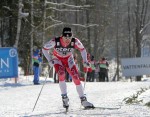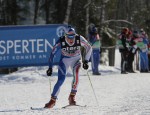
Just because it’s flat doesn’t mean it’s any easier.
A relatively tame, fast course in Drammen, Norway, was still more than enough to separate the wheat from the chaff in Sunday’s chilly World Cup qualifier—the last race before the start of the 2011 World Ski Championships in Oslo.
“Here, there’s not much for offset (V1), but you still have to hammer it out,” said Canadian Stefan Kuhn, who finished in 32nd—less than a tenth of a second from the heats.

On the men’s side, the top three finishers were predictable, with Emil Joensson in the top spot, ahead of Italian phenom Federico Pellegrino and the U.S.’s Andy Newell, who was making his first World Cup start since January.
In fourth place, however, there was a surprise: 22-year-old Canadian Len Valjas, who’s still in his rookie season on the World Cup circuit.
On a course that he described as “ideal” for him—lots of gliding—Valjas stuck his name above established stars like Norway’s Petter Northug (seventh), Sweden’s Marcus Hellner (16th), and Russia’s Alexander Panzhinskiy (18th). And he did it on a day that was arguably the most important of his career to date: by besting his teammates Kuhn and Phil Widmer, he secured one of Canada’s two open start spots for Thursday’s World Championships sprint.
“The whole time in my head, I was just [saying], ‘How bad do I want to race World Champs?’ That’s all I was thinking about the final straight,” Valjas said.
While Kuhn didn’t make the heats in Drammen, he’ll get the other open sprint spot in Oslo, as he finished in 32nd, seven positions ahead of Widmer. According to Canadian wax tech Sacha Bergeron, the starts at Worlds were assigned to the top two finishers among those three athletes.

In addition to Valjas, the Canadians put one more man into the heats, thanks to Alex Harvey’s 22nd-place finish. Devon Kershaw was 48th—a definite disappointment, given that he had won a skate sprint at the Tour de Ski earlier this year. While he was the seventh bib, he knew as soon as he crossed the line that he wasn’t in the heats. All he had to say afterward was that he didn’t know “what the f— happened”—though he appeared to show FasterSkier a scratch or some kind of blemish on one of his skis.
Americans Simi Hamilton and Lars Flora also failed to make the heats, finishing in 53rd and 75th, respectively.
“My speed wasn’t there. My breathing and everything felt really controlled and good, and I just couldn’t get my body moving,” Hamilton said. “Still got a little bit of time, so…whatever.”
On the women’s side, three North Americans qualified, led by Kikkan Randall (USA) in sixth and Canada’s Chandra Crawford in ninth. Dasha Gaiazova took 30th, grabbing the very last spot in the heats, while Sadie Bjornsen (USA), Jessie Diggins (USA), Perianne Jones (CAN), and Holly Brooks (USA) did not qualify.
Norway’s Maiken Caspersen was the surprise winner, taking her first-ever victory in a sprint qualifier; she was followed by Italy’s Magda Genuin and Sweden’s Hanna Falk. Marit Bjoergen (NOR) was seventh—.15 seconds behind Randall.
While the men clocked in at three minutes on the dot, the women were skiing their 1.2-kilometer course in just over 2:15—very short for a sprint. Still, despite the distance and the relatively relaxed profile, Randall said it wasn’t easy.
“No rest out there—working hard the whole way,” she said.
The women’s loop contains one longer, gradual hill, which did necessitate a little V1, while the men’s loop, at 1.6 kilometers, had two. But the most decisive place will likely be finish stretch, which is very long, and slightly uphill—much like the homestretch in the Otepaa, Estonia World Cup in January.
“Anything can happen in that long finish, if you’re strong,” Crawford said.

Nathaniel Herz
Nat Herz is an Alaska-based journalist who moonlights for FasterSkier as an occasional reporter and podcast host. He was FasterSkier's full-time reporter in 2010 and 2011.











